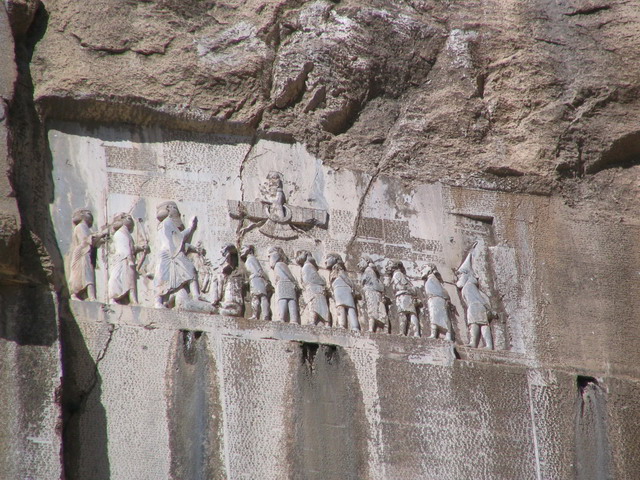Behistun Palace on:
[Wikipedia]
[Google]
[Amazon]

 Behistun palace is a ruined
Behistun palace is a ruined

 Behistun palace is a ruined
Behistun palace is a ruined Sassanid
The Sasanian () or Sassanid Empire, officially known as the Empire of Iranians (, ) and also referred to by historians as the Neo-Persian Empire, was the last Iranian empire before the early Muslim conquests of the 7th-8th centuries AD. Named ...
palace located in Bisotun
Bisotun ( fa, بيستون; also Romanized as Bīsotūn; also known as Bīsītan and Bīsītūn) is a city and capital of Bisotun District, in Harsin County, Kermanshah Province, Iran. At the 2006 census, its population was 2,075, in 527 famil ...
, from Kermanshah
Kermanshah ( fa, کرمانشاه, Kermânšâh ), also known as Kermashan (; romanized: Kirmaşan), is the capital of Kermanshah Province, located from Tehran in the western part of Iran. According to the 2016 census, its population is 946,68 ...
, Iran
Iran, officially the Islamic Republic of Iran, and also called Persia, is a country located in Western Asia. It is bordered by Iraq and Turkey to the west, by Azerbaijan and Armenia to the northwest, by the Caspian Sea and Turkmeni ...
. It faces the cliff with the much older Behistun inscription and rock relief
A rock relief or rock-cut relief is a relief sculpture carved on solid or "living rock" such as a cliff, rather than a detached piece of stone. They are a category of rock art, and sometimes found as part of, or in conjunction with, ro ...
, across the ancient road running between Behistun mountain and Behistun lake. The palace has long been regarded in Persian tradition as a residence of Shirin
Shirin ( fa, شیرین; died 628) was a Christian wife of the Sasanian King of Kings (''shahanshah'') Khosrow II (). In the revolution after the death of Khosrow's father Hormizd IV, the General Bahram Chobin took power over the Persian empire. S ...
, queen of Khosrau II
Khosrow II (spelled Chosroes II in classical sources; pal, 𐭧𐭥𐭮𐭫𐭥𐭣𐭩, Husrō), also known as Khosrow Parviz (New Persian: , "Khosrow the Victorious"), is considered to be the last great Sasanian king (shah) of Iran, ruling fr ...
, the Sassanid Shah of Persia who reigned from 590 to 628, shortly before the Muslim conquest of Persia
The Muslim conquest of Persia, also known as the Arab conquest of Iran, was carried out by the Rashidun Caliphate from 633 to 654 AD and led to the fall of the Sasanian Empire as well as the eventual decline of the Zoroastrian religion.
Th ...
. This connection is first documented, in surviving records, by early Islamic geographers, and is elaborated in various later stories and myths, as a fictionalized Shirin
Shirin ( fa, شیرین; died 628) was a Christian wife of the Sasanian King of Kings (''shahanshah'') Khosrow II (). In the revolution after the death of Khosrow's father Hormizd IV, the General Bahram Chobin took power over the Persian empire. S ...
became an important heroine of later Persian literature
Persian literature ( fa, ادبیات فارسی, Adabiyâte fârsi, ) comprises oral compositions and written texts in the Persian language and is one of the world's oldest literatures. It spans over two-and-a-half millennia. Its sources h ...
, such as the ''Shahnameh
The ''Shahnameh'' or ''Shahnama'' ( fa, شاهنامه, Šāhnāme, lit=The Book of Kings, ) is a long epic poem written by the Persian poet Ferdowsi between c. 977 and 1010 CE and is the national epic of Greater Iran. Consisting of some 50,00 ...
'' ("Book of Kings").Baum, later chapters It is included in the UNESCO
The United Nations Educational, Scientific and Cultural Organization is a specialized agency of the United Nations (UN) aimed at promoting world peace and security through international cooperation in education, arts, sciences and culture. It ...
World Heritage Site
A World Heritage Site is a landmark or area with legal protection by an international convention administered by the United Nations Educational, Scientific and Cultural Organization (UNESCO). World Heritage Sites are designated by UNESCO for h ...
of Bisotun.
See also
* Behistun Inscription *Darius I of Persia
Darius I ( peo, 𐎭𐎠𐎼𐎹𐎺𐎢𐏁 ; grc-gre, Δαρεῖος ; – 486 BCE), commonly known as Darius the Great, was a Persian ruler who served as the third King of Kings of the Achaemenid Empire, reigning from 522 BCE until his d ...
* Taq-e Bostan
Taq-e Bostan ( fa, طاق بستان, ) is a site with a series of large rock reliefs from the era of the Sassanid Empire of Persia (Iran), carved around the 4th century CE.
This example of Persian Sassanid art is located 5 km from the ...
(Rock reliefs of various Sassanid kings)
* Achaemenid empire
The Achaemenid Empire or Achaemenian Empire (; peo, 𐎧𐏁𐏂, , ), also called the First Persian Empire, was an ancient Iranian empire founded by Cyrus the Great in 550 BC. Based in Western Asia, it was contemporarily the largest em ...
* Iran National Heritage List
Iran National Heritage List is a register of nationally significant monuments, places, buildings, events, etc., officially registered under the National Heritage Preservation Act of 1930. According to Article 1 of this law, "All the industrial mon ...
References
{{Palaces in Iran World Heritage Sites in Iran Sasanian architecture Buildings and structures in Kermanshah ProvincePalace
A palace is a grand residence, especially a royal residence, or the home of a head of state or some other high-ranking dignitary, such as a bishop or archbishop. The word is derived from the Latin name palātium, for Palatine Hill in Rome which ...